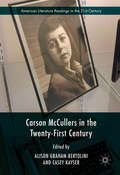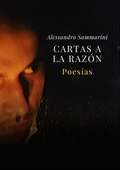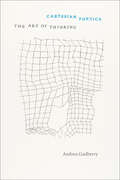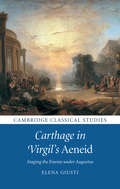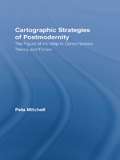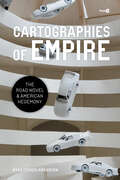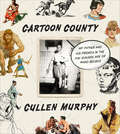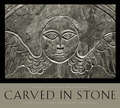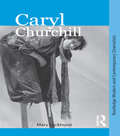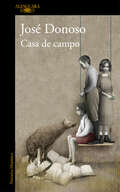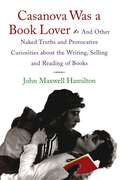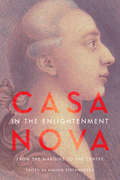- Table View
- List View
Carrying All before Her: Celebrity Pregnancy and the London Stage, 1689-1800 (Performing Celebrity)
by Chelsea PhillipsThe rise of celebrity stage actresses in the long eighteenth century created a class of women who worked in the public sphere while facing considerable scrutiny about their offstage lives. Such powerful celebrity women used the cultural and affective significance of their reproductive bodies to leverage audience support and interest to advance their careers, and eighteenth-century London patent theatres even capitalized on their pregnancies. Carrying All Before Her uses the reproductive histories of six celebrity women (Susanna Mountfort Verbruggen, Anne Oldfield, Susannah Cibber, George Anne Bellamy, Sarah Siddons, and Dorothy Jordan) to demonstrate that pregnancy affected celebrity identity, impacted audience reception and interpretation of performance, changed company repertory and altered company hierarchy, influenced the development and performance of new plays, and had substantial economic consequences for both women and the companies for which they worked. Deepening the fields of celebrity, theatre, and women's studies, as well as social and medical histories, Phillips reveals an untapped history whose relevance and impact persists today.
Carrying Verbs Across the Channel: Modelling Change in Bilingual Medieval England (New Approaches to English Historical Linguistics)
by Achim Stein Michael Percillier Yela Schauwecker Carola TripsThis book examines grammatical changes that took place in the medieval language contact situation between English and French from 1066 until 1500. It investigates structural copying phenomena and their connection with the lexicon, finding that copying of lexical verbs with a predicate-argument structure accelerated wider grammatical changes, and shows why the traditional notion of borrowing should be replaced with the more adequate concept of copying. The authors start by taking a fresh look at the relationship between Old French and Middle English in light of recent developments in the fi eld of linguistics, arguing that what has traditionally been seen as a diglossic situation (i.e., as contact between the dominating speakers of French and the native speakers of English) should instead be analysed through the framework of bilingualism. The two contact scenarios under scrutiny are the ones between Old French and Middle English and Middle English and the contact variety of Anglo-French. On the basis of their case studies they develop a holistic model of contact-induced change that integrates the bilingual individual as well as the speech community and its sociolinguistic background. This book will be of interest to students and scholars of language history and change, language contact and acquisition, sociolinguistics, multilingualism, and psycholinguistics.
Carson McCullers in the Twenty-First Century (American Literature Readings in the 21st Century)
by Alison Graham-Bertolini and Casey KayserThe contributors to this volume use diverse critical techniques to identify how Carson McCullers’ writing engages with and critiques modern social structures and how her work resonates with a twenty-first century audience. The collection includes chapters about McCullers’ fiction, autobiographical writing, and dramatic works, and is groundbreaking because it includes the first detailed scholarly examination of new archival material donated to Columbus State University after the 2013 death of Dr. Mary Mercer, McCullers’ psychiatrist and friend, including transcripts of the psychiatric sessions that took place between McCullers and Mercer in 1958. Further, the collection covers the scope of McCullers’ canon of work, such as The Heart Is a Lonely Hunter (1940), The Member of the Wedding (1946), and Ballad of the Sad Café (1943), through lenses that are of growing interest in contemporary literary studies, including comparative transatlantic readings, queer theory, disability studies, and critical animal theory, among others.
Carta al teninente Shogún
by Lurgio Gavilán"Allí estás, con uniforme, pasamontaña, rastrillando el fusil. Listo para abrir fuego. Mirándome". En un acto epifánico, inexplicable, un militar decide detener el fuego en las alturas andinas y salvar la vida de un niño adoctrinado por Sendero Luminoso, Lurgio Gavilán. Décadas después, pasado el fragor del combate y el tiempo de las heridas, ese muchacho convertido en hombre busca a su viejo salvador para tratar de entender las motivaciones de su cariño y de su dureza. Como toda epístola, Carta al teniente Shogún apela a un interlocutor, aunque de este solo sepamos lo que el autor revela. Las arms que utiliza son retóricas e intelectuales, y si bien su propósito es personal, su motivación es filosófica: ¿qué lleva a un hombre a matar a otro? ¿Cómo una vida construida entre campos y riachuelos se convierte en una tragedia cruenta por cordilleras y cuevas? ¿Cuál es el idioma que se debe emplear para referir a los parientes perdidos, a las víctimas acuchilladas y a los pueblos arrasados? ¿Y cuál para los colibríes? ¿Quién y cómo ejerce el poder y a quién debe rendir cuentas? Toda misiva es un intento por aproximar una visión del mundo a otra. Lurgio Gavilán ha escrito esta carta para el teniente Shogún, pero también para sí mismo y para todos aquellos que buscan humanidad donde parece no haberla.
Cartas a la razón
by Marlo LópezEste camino mío es un viaje a lo largo de veinte años, en el que hay un amor no correspondido que lleva inevitablemente a una crisis de identidad, desarrollándose luego en una nueva relación que llega a la coronación del sueño de amor. Se concluye con un intenso análisis del período vivido, una especie de reelaboración del pasado. De lo alto de tantos estados emocionales se describe la visión en el tiempo, para impulsarse con la mente a buscar y a encontrar personales verdades. La búsqueda de mí mismo comenzó con la intención de amar, con el deseo de enamorarme. El amor es vivido con una reflexión racional y una participación infantil que descubre uno de los planes más bajos del miedo: el miedo de amar. Al revelarse los miedos se descubren las ansias, defensas personales que hacen huir de un peligro irracional, hasta revelar la verdad, en este caso yo mismo.
Cartas a un joven médico
by Federico Ortiz QuezadaLa relación entre la reflexión filosófica y el estudio de la medicina es mucho más íntima de lo que pensamos... A veces son exactamente lo mismo.Las cartas literarias han sido un medio privilegiado para que los sabios de diversas disciplinas transmitan sus conocimientos a los jóvenes, ansiosos o inseguros por iniciarse en su profesión. Ahí están los celebres ejemplos de Rilke, Vargas Llosa y Siqueiros. Pero esta preocupación por compartir los conocimientos y experiencias de toda una vida no es exclusiva de escritores y artistas; también la comparten los hombres de ciencia, y tal es el caso de Federico Ortiz Quezada. Cartas a un joven médico conjuga las dos grandes pasiones de su autor: la medicina y la literatura. A través de 28 cartas, el doctor Ortiz Quezada se manifiesta por una medicina con vocación humanista, al tiempo que reflexiona sobre el sentido último de esta profesión, sobre la naturaleza del sufrimiento y sobre la condición pluridimensional del ser humano. Asimismo, hace una severa crítica de los principales vicios de la medicina moderna: la superespecialización, la tecnificación y la burocratización.Este libro puede leerse como una historia de la ciencia médica, cuyo foco o eje rector es la relación entre escritura y medicina, pues para el doctor Federico Ortiz Quezada ambas disciplinas persiguen el mismo fin: la comprensión del hombre y lo humano. Una y otra se complementan en la misma búsqueda.
Cartas extraordinarias
by María NegroniHomenaje, arte poética y gozo se unen en este libro único, exquisito y feliz, en el que textos e imágenes componen una correspondencia milagrosa. Homenaje, arte poética y gozo se unen en este libro único, exquisito y feliz, en el que textos e imágenes componen una correspondencia milagrosa. Como un regreso y un reconocimiento a las obras y autores que formaron la biblioteca de nuestra infancia y adolescencia, María Negroni escribió este conjunto de "cartas extraordinarias" que iluminan el mundo en que vivieron y crearon Louisa May Alcott, Emilio Salgari, Charles Dickens, Mark Twain, Jack London y tantos otros grandes escritores del siglo XIX, cuyas narraciones serán siempre el corazón de nuestro ADN literario. Se trata de cartas cuidadosamente apócrifas, a veces improbables, o imposibles por anacrónicas, a veces incluso dirigidas a personajes de ficción que, sin ignorar las circunstancias biográficas, históricas y sociales de los corresponsales, emprenden, casi con saña, una empedernida reflexión en torno a los costos y peligros de la actividad literaria. Los bellísimos y delicados collages de Fidel Sclavo funcionan, en cada caso, a modo de preciso y sugestivo comentario. La crítica ha dicho... «Negroni entabla una correspondencia con las lecturas de su propia infancia para continuar preguntándose, mediante las voces de otros escritores, sobre las hendiduras de la actividad literaria.» Mariana Amato
Cartesian Poetics: The Art of Thinking (Thinking Literature)
by Andrea GadberryWhat is thinking? What does it feel like? What is it good for? Andrea Gadberry looks for answers to these questions in the philosophy of René Descartes and finds them in the philosopher’s implicit poetics. Gadberry argues that Descartes’s thought was crucially enabled by poetry and shows how markers of poetic genres from love lyric and elegy to the puzzling forms of the riddle and the anagram betray an impassioned negotiation with the difficulties of thought and its limits. Where others have seen Cartesian philosophy as a triumph of reason, Gadberry reveals that the philosopher accused of having “slashed poetry’s throat” instead enlisted poetic form to contain thought’s frustrations. Gadberry’s approach to seventeenth-century writings poses questions urgent for the twenty-first. Bringing literature and philosophy into rich dialogue, Gadberry centers close reading as a method uniquely equipped to manage skepticism, tolerate critical ambivalence, and detect feeling in philosophy. Helping us read classic moments of philosophical argumentation in a new light, this elegant study also expands outward to redefine thinking in light of its poetic formations.
Carthage in Virgil’s Aeneid: Staging the Enemy Under Augustus (Cambridge Classical Studies)
by Elena GiustiFounded upon more than a century of civil bloodshed, the first imperial regime of ancient Rome, the Principate of Caesar Augustus, looked at Rome's distant and glorious past in order to justify and promote its existence under the disguise of a restoration of the old Republic. In doing so, it used and revisited the history and myth of Rome's major success against external enemies: the wars against Carthage. This book explores the ideological use of Carthage in the most authoritative of the Augustan literary texts, the Aeneid of Virgil. It analyses the ideological portrait of Carthaginians from the middle Republic and the truth-twisting involved in writing about the Punic Wars under the Principate. It also investigates the mirroring between Carthage and Rome in a poem whose primary concern was rather the traumatic memory of Civil War and the subsequent subversion of Rome's Republican institutions through the establishment of Augustus' Principate.<P><P> Provides a new literary and historicist reading of Virgil's Aeneid and its Augustan context.<P> Investigates afresh the ideology of Caesar Augustus in relation to the wider history of ideologies and autocratic regimes.<P> Engages in a range of approaches of great current interest, such as the representation of the other and the erasure of subalterns from classical texts.
Cartografía personal: Escritos y escritores de América Latina
by Jorge LafforgueCartografía personal no sólo condensa con lucidez y humor momentos sobresalientes de las letras latinoamericanas. También es una i nvitación amable a volver la mirada sobre escritos y escritores descollantes, cuyo rostro el autor se empeña en dibujar con pulso decidido y palabra sagaz. Cartografía personal no sólo condensa con lucidez y humor momentos sobresalientes de las letras latinoamericanas. También es una invitación amable a volver la mirada sobre escritos y escritores descollantes, cuyo rostro el autor se empeña en dibujar con pulso decidido y palabra sagaz. Toda cartografía que intente dibujar el mapa de la literatura latinoamericana será siempre una aproximación. Porque ese mapa es uno y es múltiple. Su trazado carece de una fórmula fija, y su continuo movimiento tampoco permite establecerlo. De ahí que esta Cartografía recurra a diversos procedimientos para acercarse a ese mapa esquivo: entrevistas a Pablo Neruda, Borges y Jorge Amado conviven con ensayos sobre el boom de los sesenta o estrategias de los escritores para salvaguardar su oficio bajo la dictadura, así como con pormenorizados estudios críticos, rescates testimoniales y apuntes imprescindibles para trazar un panorama de la producción literaria de la segunda mitad del siglo XX. La extensa trayectoria de Jorge Lafforgue como crítico, docente y periodista establece los cimientos de esta estructura heterogénea, y la argamasa que la une es su voz particular, única, fruto de una intensa experiencia con la mejor literatura.
Cartographic Humanism: The Making of Early Modern Europe
by Katharina N. PiechockiPiechocki calls for an examination of the idea of Europe as a geographical concept, tracing its development in the 15th and 16th centuries. What is “Europe,” and when did it come to be? In the Renaissance, the term “Europe” circulated widely. But as Katharina N. Piechocki argues in this compelling book, the continent itself was only in the making in the fifteenth and sixteenth centuries.Cartographic Humanism sheds new light on how humanists negotiated and defined Europe’s boundaries at a momentous shift in the continent’s formation: when a new imagining of Europe was driven by the rise of cartography. As Piechocki shows, this tool of geography, philosophy, and philology was used not only to represent but, more importantly, also to shape and promote an image of Europe quite unparalleled in previous centuries. Engaging with poets, historians, and mapmakers, Piechocki resists an easy categorization of the continent, scrutinizing Europe as an unexamined category that demands a much more careful and nuanced investigation than scholars of early modernity have hitherto undertaken. Unprecedented in its geographic scope, Cartographic Humanism is the first book to chart new itineraries across Europe as it brings France, Germany, Italy, Poland, and Portugal into a lively, interdisciplinary dialogue.
Cartographic Strategies of Postmodernity: The Figure of the Map in Contemporary Theory and Fiction (Routledge Studies in Twentieth-Century Literature)
by Peta MitchellThe last fifty years have witnessed the growing pervasiveness of the figure of the map in critical, theoretical, and fictional discourse. References to mapping and cartography are endemic in poststructuralist theory, and, similarly, geographically and culturally diverse authors of twentieth-century fiction seem fixated upon mapping. While the map metaphor has been employed for centuries to highlight issues of textual representation and epistemology, the map metaphor itself has undergone a transformation in the postmodern era. This metamorphosis draws together poststructuralist conceptualizations of epistemology, textuality, cartography, and metaphor, and signals a shift away from modernist preoccupations with temporality and objectivity to a postmodern pragmatics of spatiality and subjectivity. Cartographic Strategies of Postmodernity charts this metamorphosis of cartographic metaphor, and argues that the ongoing reworking of the map metaphor renders it a formative and performative metaphor of postmodernity.
Cartographies Of Desire: Male-male Sexuality In Japanese Discourse, 1600-1950
by Gregory M. PflugfelderIn this sweeping study of the mapping and remapping of male-male sexuality over four centuries of Japanese history, Gregory Pflugfelder explores the languages of medicine, law, and popular culture from the seventeenth century through the American Occupation. Pflugfelder opens with fascinating speculations about how an Edo translator might grapple with a twentieth-century text on homosexuality, then turns to law, literature, newspaper articles, medical tracts, and other sources to discover Japanese attitudes toward sexuality over the centuries. During each of three major eras, he argues, one field dominated discourse on male-male sexual relations: popular culture in the Edo period (1600-1868), jurisprudence in the Meiji period (1868-1912), and medicine in the twentieth century. This multidisciplinary and theoretically engaged analysis will interest not only students and scholars of Japan but also readers of gay studies, literary studies, gender studies, and cultural studies.
Cartographies of Disappearance: Vestiges of Everyday Life in Literature (Toronto Iberic)
by Enric BouThe everyday can be defined as the routine that happens day after day and becomes our most permanent reality. It is made up of different identifiable areas of life, such as the home, the street, the subway, the park, the workplace, and local institutions. Focusing on literary texts and artistic forms, Cartographies of Disappearance addresses representations of everyday life from varying perspectives. Opening our eyes to a new understanding of our daily environment, the book presents detailed readings of texts, practices, and mythologies of everyday life within Spanish and Catalan culture. Enric Bou examines how and to what extent issues of identity, space, memory, and immigration have impacted everyday life in Spain. The book explores five major instances of representing the everyday in literature and the arts: routines and disappearances, observations of the nearby, the uses of public transportation, thanatourism, and food. Acknowledging that the everyday is a matter of study and observation, the book reveals how to look at the world from a different perspective. While the everyday is filled with the unorganized accumulation of objects and beings, Cartographies of Disappearance addresses the inclination to make sense of it all.
Cartographies of Empire: The Road Novel and American Hegemony (Post*45)
by Myka Tucker-AbramsonThe road novel is often dismissed as a mundane, nostalgic genre: Jack, Sal, and other tedious white men on the road trying to recapture an authentic youth and American past that never existed. Yet, new road novels appear every year, tackling unexpected questions and spanning new geographies, from Mexico, Brazil, Bulgaria, Palestine, Ukraine, and former-Yugoslavia. Why did the road novel emerge and why does it persist? What does it do and why has it traveled so widely? Myka Tucker-Abramson draws from an archive of more than 140 global road novels from over twenty countries, challenging dominant conceptions of the road novel as primarily concerned with American experiences and subjectivities. Grounding her analysis in materialist theories of genre, world-ecology and commodity frontier frameworks, and post-45 American literary studies, Tucker-Abramson persuasively argues that the road novel is a genre specific to, coterminous with, and revealing of US hegemony's global trajectory. Shifting our focus from Americanness to the fraught geopolitics of US Empire, from the car to the built environment through which it moves, and from passengers to those left behind, Tucker-Abramson remaps the road novel, elucidating the genre's unique ability both to reveal the violent and vertiginous processes of capitalist modernization and to obfuscate these harsh truths through seductive narratives of individual success and failure.
Cartographies of Exile: A New Spatial Literacy (Routledge Interdisciplinary Perspectives on Literature)
by Karen Elizabeth BishopThis book proposes a fundamental relationship between exile and mapping. It seeks to understand the cartographic imperative inherent in the exilic condition, the exilic impulses fundamental to mapping, and the varied forms of description proper to both. The vital intimacy of the relationship between exile and mapping compels a new spatial literacy that requires the cultivation of localized, dynamic reading practices attuned to the complexities of understanding space as text and texts as spatial artifacts. The collection asks: what kinds of maps do exiles make? How are they conceived, drawn, read? Are they private maps or can they be shaped collectively? What is their relationship to memory and history? How do maps provide for new ways of imagining the fractured experience of exile and offer up both new strategies for reading displacement and new displaced reading strategies? Where does exilic mapping fit into a history of cartography, particularly within the twentieth-century spatial turn? The original work that makes up this interdisciplinary collection presents a varied look at cartographic strategies employed in writing, art, and film from the pre-Contact Americas to the Renaissance to late postmodernism; the effects of exile, in its many manifestations, on cartographic textual systems, ways of seeing, and forms of reading; the challenges of traversing and mapping unstable landscapes and restrictive social and political networks; and the felicities and difficulties of both giving into the map and attempting to escape the map that provides for exile in the first place. Cartographies of Exile will be of interest to students and scholars working in literary and cultural studies; gender, sexuality, and race studies; anthropology; art history and architecture; film, performance, visual studies; and the fine arts.
Cartoon Conflicts: Contemporary Controversies and Historical Precedents (Palgrave Studies in the History of the Media)
by Ritu Gairola Khanduri Richard Scully Paulo Jorge FernandesThis edited collection of new research highlights the way in which the cartoon - long regarded as a staple of journalism and freedom of expression - faces new challenges in the twenty-first century that can be far better understood and appreciated if one takes an historical perspective. Current debates over the limits of freedom of expression, 'political correctness', and 'cancel culture' all have their precedents in past controversies over cartoons and caricature; indeed there is a definite continuum between these past instances of debate and their present manifestations. Chapters 2 and 10 are available open access under a Creative Commons Attribution 4.0 International License via link.springer.com.
Cartoon County: My Father and His Friends in the Golden Age of Make-Believe
by Cullen MurphyA poignant history of the cartoonists and illustrators from the Connecticut SchoolFor a period of about fifty years, right in the middle of the American Century, many of the the nation’s top comic-strip cartoonists, gag cartoonists, and magazine illustrators lived within a stone’s throw of one another in the southwestern corner of Connecticut—a bit of bohemia in the middle of those men in their gray flannel suits. Cullen Murphy’s father, John Cullen Murphy, drew the wildly popular comic strips Prince Valiant and Big Ben Bolt, and was the heart of this artistic milieu. Comic strips and gag cartoons read by hundreds of millions were created in this tight-knit group—Superman, Beetle Bailey, Snuffy Smith, Rip Kirby, Hagar the Horrible, Hi and Lois, Nancy, Sam & Silo, Amy, The Wizard of Id, The Heart of Juliet Jones, Family Circus, Joe Palooka, and The Lockhorns, among others. Cartoonists and their art were a pop-cultural force in a way that few today remember. Anarchic and deeply creative, the cartoonists were independent spirits whose artistic talents had mainly been forged during service in World War II.Illustrated with never-before-seen photographs, cartoons, and drawings, Cartoon County brings the postwar American era alive, told through the relationship of a son to his father, an extraordinarily talented and generous man who had been trained by Norman Rockwell. Cartoon County gives us a glimpse into a very special community—and of an America that used to be.
Cartoons and Antisemitism: Visual Politics of Interwar Poland
by Ewa StańczykAntisemitic caricatures had existed in Polish society since at least the mid-nineteenth century. But never had the devastating impacts of this imagery been fully realized or so blatantly apparent than on the eve of the Second World War. In Cartoons and Antisemitism: Visual Politics of Interwar Poland, scholar Ewa Stańczyk explores how illustrators conceived of Jewish people in satirical drawing and reflected on the burning political questions of the day. Incorporating hundreds of cartoons, satirical texts, and newspaper articles from the 1930s, Stańczyk investigates how a visual culture that was essentially hostile to Jews penetrated deep and wide into Polish print media. In her sensitive analysis of these sources, the first of this kind in English, the author examines how major satirical magazines intervened in the ongoing events and contributed to the racialized political climate of the time.Paying close attention to the antisemitic tropes that were both local and global, Stańczyk reflects on the role of pictorial humor in the transmission of visual antisemitism across historical and geographical borders. As she discusses the communities of artists, publishers, and political commentators who made up the visual culture of the day, Stańczyk tells a captivating story of people who served the antisemitic cause, and those who chose to oppose it.
Carved in Stone: The Artistry of Early New England Gravestones
by William Gilson Thomas E. GibsonEvocative photographs and essay illuminate early American gravestones Gravestones are colonial America's earliest sculpture and they provide a unique physical link to the European people who settled here. Carved in Stone book is an elegant collection of over eighty fine duotone photographs, each a personal meditation on an old stone carving, and on New England's past, where these stones tell stories about death at sea, epidemics such as small pox, the loss of children, and a grim view of the afterlife. The essay is a graceful narrative that explores a long personal involvement with the stones and their placement in New England landscape, and attempts to trace the curious and imperfectly documented story of carvers. Brief quotes from early New England writers accompany the images, and captions provide basic information about each stone. These meditative portraits present an intimate view of figures from New England graveyards and will be enjoyed by anyone with an interest in early Americana and fine art photography.
Caryl Churchill (Routledge Modern and Contemporary Dramatists)
by Mary LuckhurstOne of Europe's greatest playwrights, Caryl Churchill has been internationally celebrated for four decades. She has exploded the narrow definitions of political theatre to write consistently hard-edged and innovative work. Always unpredictable in her stage experiments, her plays have stretched the relationships between form and content, actor and spectator to their limits. This new critical introduction to Churchill examines her political agendas, her collaborations with other practitioners, and looks at specific production histories of her plays. Churchill's work continues to have profound resonances with her audiences and this book explores her preoccupation with representing such phenomena as capitalism, genocide, environmental issues, identity, psychiatry and mental illness, parenting, violence and terrorism. It includes new interviews with actors and directors of her work, and gathers together source material from her wide-ranging career.
Casa de campo
by José DonosoLa gran metáfora histórica de Donoso; la representación en clave del Chile de los años 70 y del golpe militar. Casa de campo es una brillante alegoría del poder y la rebelión. La mansión señorial donde los Ventura, sus cónyuges y sus treinta y cinco hijos pasan el verano, lejos de la civilización, se alza como un espejismo en medio de la llanura. Por sus salones, pasillos, escalinatas y torreones deambulan los niños, poblando la casa con intrigas, transgresiones y juegos que cuestionan una perversión mayor: el orden impuesto por sus aristocráticos padres. Los Ventura organizan un fastuoso día de campo para los mayores, y encierran a sus hijos en la enorme mansión, cercada por una reja de lanzas... ¿Qué hay más allá? La llanura ilimitada, los antropófagos, la naturaleza y sus fuerzas nodomadas. Pero también en los niños anida la subversión. Y están solos.
Casablanca (SparkNotes Film Guide)
by SparkNotesCasablanca (SparkNotes Film Guide) Making the reading experience fun! SparkNotes Film Guides are one-stop guides to great works of film–masterpieces that are the foundations of filmmaking and film studies. Inside each guide you&’ll find thorough, insightful overviews of films from a variety of genres, styles, and time periods. Each film guide contains:Information about the director and the context in which the film was made Thoughtful analysis of major characters Details about themes, motifs, and symbols Explanations of the most important lines of dialogue In-depth discussions about what makes a film so remarkable SparkNotes Film Guides are an invaluable resource for students or anyone who wants to gain a deeper understanding of the great films they know and love.
Casanova Was A Book Lover: And Other Naked Truths and Provocative Curiosities about the Writing, Selling, and Reading of Books
by John Maxwell HamiltonEveryone knows which books people buy; they can just look at the best-seller lists. But who knows which books people steal? Who, for that matter, knows that authors ruin the book market by writing too much? Or why book critics are not critical? Or why librarians need to throw out more books? Who, indeed, knows the answer to that all-important question in our democracy: should presidents and presidential candidates write books? (The answer is no.)In this irreverent analysis of the book industry, John Maxwell Hamilton -- a longtime journalist and public radio commentator -- answers these questions and many more, proving that the best way to study books is not to take them too seriously. He provides a rich history of the book -- from the days when monks laboriously hand-copied texts to the tidal wave of Titanic tie-ins -- and gives a succinct overview of the state of the industry today, including writing, marketing, promoting, reviewing, ghostwriting, and collecting.Throughout, Hamilton peppers his prose with spicy tidbits of information that will fascinate bibliophiles everywhere. For instance, did you know that Walt Whitman was fired from a government job because his boss found Leaves of Grass, and its author, immoral? Or that the most stolen book in the United States is the Bible, followed by The Joy of Sex? How about that Dan Quayle's 1989 Christmas card read, "May our nation continue to be a beakon of hope to the world"? Or that Casanova was an ardent lover of books as well as women?Hamilton offers an inside look at the history and business of book reviewing, explaining why, more often than not, reviewers resemble "counselors at a self-esteem camp" and examining the enormous impact of the "Oprah effect" on the market. As the self-appointed Emily Post of the book world, he advises publishers, authors, and readers on proper etiquette for everything from book parties ("Feel free to build a party around a theme in a book, no matter how tacky") and jacket photos ("You should not show off your new baby unless [your] book [is] about raising kids"), to book signings ("Just because an author has given you an autograph does not mean they want to become your pen pal") and promotion by friends and relatives ("They should carry the book at all times on public transportation with the cover showing").Both edifying and enjoyable, Casanova Was a Book Lover fills a Grand Canyon--sized void in the literature on literature. It is indispensable for book enthusiasts who want to know the naked truth about reading, writing, and publishing.
Casanova in the Enlightenment: From the Margins to the Centre (UCLA Clark Memorial Library Series)
Illuminating the legend that Giacomo Casanova singlehandedly created in his famous – and at times infamous – autobiography, The History of My Life, this book provides a timely reassessment of Casanova’s role and importance as an author of the European Enlightenment. From the margins of libertine authorship where he has been traditionally relegated, the various essays in this collection reposition Casanova at the heart of Enlightenment debates on medicine, sociability, gender, and writing. Based on new scholarship, this reappraisal of a key Enlightenment figure explores the period’s fascination with ethnography, its scientific societies, and its understanding of gender, medicine, and women. Casanova is here finally granted his rightful place in cultural and literary history, a place which explains his enduring yet controversial reputation as a figure of seduction and adventure.


